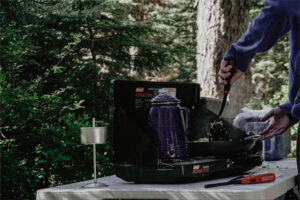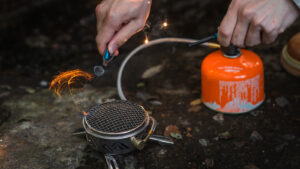
Unlike traditional models that suffer from reduced oxygen levels and low boiling points, high-altitude camping stoves are designed to operate efficiently in these conditions. This blog post entails some vital maintenance advice for a thin mountain air-running high altitude camping stove. This blog post will also teach you how to choose a fuel canister size for a high altitude trip.
What Is High-Altitude Stove And How Do They Differ From Traditional Stoves
High Altitude is synonymous with mountainous areas. They work well even with less oxygen in them. Traditional stoves find it difficult to perform properly as they do not operate well in such areas due to lower air pressure and cold weather.
High-altitude stoves address these issues by using pressure regulators and sophisticated fuel systems. Consequently, constant heat delivery is guaranteed through this modification.
Does a Camp Stove Need Special Adjustments for High Altitude Use?
Yes, if you want to use a camp stove at high altitudes, there must be some special adjustments. This is because the air pressure is low at these heights, which directly affects the working of a stove. Traditional stoves meant for lower altitudes have problems functioning correctly in low-oxygen environments as well as reduced pressures.
Pressure regulators are one way you can get better performance out of your stove when using it at above-average elevations. Maintaining a steady flow of fuel even with varying atmospheric conditions helps ensure uniform heat output under changing weather conditions. In fact, they allow reliable operation during hard times when oxygen levels turn down and temperatures drop to freezing.
Also, adjusting the air intake on the stove is important. Thus, by increasing airflow, you make up for a lack of oxygen, which maintains a constant flame that burns well. Some models have systems that enable manual control over air inflow, while others require certain settings or add-ons to be used at higher heights.
Moreover, regular maintenance should not be overlooked. These clogs stop the flow of fuel, thus blocking burner ports and fuel lines on your camp stove, resulting in low-efficiency rates, so always clean them. Also, leaks should be checked while connections are tightened where necessary for improved performance.
Appropriate understanding and implementation of these adjustments will help you realize maximum results from your high-altitude camping stove being used at high altitudes.
 Choosing the Right Fuel and Canister Size
Choosing the Right Fuel and Canister Size
If you want your stove to run well in mountainous conditions, it is important that you select the right fuel for high-altitude camping. Below is how you can make a good choice.
The most common type of fuel for high-altitude stoves is a blend of isobutane and propane mixtures. These combinations are preferable due to the fact that they vaporize more completely in cold weather, which is mostly found at higher heights. That means even if there’s a drop in temperature, this will not affect its function.
Pure butane should be avoided when camping at altitudes above 6,000 feet. This form of gas does not vaporize easily and may have difficulties in colder areas where mountain air gets chilly. In such cases, range performance appears erratic, including failure to ignite.
Also, consider the size of the fuel canister used. 100- or 220-gram cans are better for weekend trips or solo camping. These are lightweight and compact in design; they can be easily adjusted according to your backpack. What’s more, these smaller cans occupy less space, which makes them great for minimalist camping set-ups.
Alternatively, bigger tanks ranging from 450 g up to 1 kg come in handy during extended trips like group camps. This reduces the frequency at which one needs to refuel and also reduces the need to carry several canisters. Although larger canisters are heavier and bulkier, their long fuel supply will make sure you have enough fuel for cooking over long periods without any interruptions.
When it comes to choosing a fuel canister size for high-altitude camping trips, always ensure compatibility with your stove model. Some camping stoves are designed to work with specific canister sizes due to differences in threading or gas flow requirements.
Manufacturers often provide guidance on which canister sizes are compatible with their stoves in the product manual or on their website. If your stove allows for flexibility in fuel canister size, consider the practical aspects of your camping trip.
By selecting the right size of a fuel canister based on your camping needs as well as stove compatibility, it leads to more efficiency, convenience, and enjoyment while camping at high altitudes.
 Maintenance Tips
Maintenance Tips
- Regular Cleaning: Clean the stove burner and fuel lines to avoid clogs.
- Check for leaks: Check for leaks in fuel lines and connections each time before using it.
- Carry spare parts: Make sure you also have spare O-rings and maintenance kits handy for quick repairs.
- Store Properly: When not being used, keep your stove in a dry, protected spot.
- Test before trips: Ensure that everything is functioning properly by running a test at home.
Conclusion:
Therefore, understanding adjustments, choosing the right fuel, canister size for high altitude camping trips wisely, and maintaining equipment diligently are the basic requirements for mastering how to use a high-altitude camping stove. Unlike traditional stoves that struggle under such conditions, high-altitude stoves come with pressure regulators, which make them very reliable. To ensure efficient cooking all through your trip, consider opting for isobutane-propane mixes as well as selecting the right canister size.
An uninterrupted performance of any stove calls for regular cleaning as well as checking whether there are any clogs. Observe these steps to improve safety, save on fuel, and prepare meals seamlessly while enjoying breathtaking scenery in high-altitude environments.
Looking for reliable camping stove supplier? At Deermaple, we specialize in ODM service, offering high-quality, innovative stoves tailored to your needs. If you are interested in camping stove wholesale , please contact us.

 Choosing the Right Fuel and Canister Size
Choosing the Right Fuel and Canister Size Maintenance Tips
Maintenance Tips







